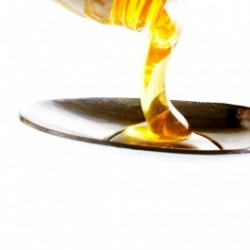
For thousands of years, honey has been harvested. Mankind has used honey for nearly everything, including food, alcohol and even medicine. However, one form of honey, manuka honey, has received a lot of attention within the past 30 years specifically for its amazing medicinal and healing properties.
What Makes Manuka Honey So Special?
Manuka honey is derived from bees that pollinate the manuka flower. New Zealand is the only place where manuka flowers are grown. All bees create a natural preservative called glucose oxidase. When this preservative is exposed to the moisture of the human body, it creates hydrogen peroxide. Hydrogen peroxide acts as a natural antibacterial in all honey. However, manuka honey has much more. Methylglyoxal is normally found in trace amounts honey, but manuka honey retains a high concentration. Methylglyoxal is touted for its antibiotic properties, which paired with hydrogen peroxide, provides a powerful bacterial killer. For this reason, a special rating system has been given to manuka honey to measure its potency.
How is the Potency of Manuka Honey Measured?
There are two standard rating systems for manuka honey. Unique Manuka Factor, UMF for short, measures the antibacterial performance of the honey versus a standard disinfectant. A rating of 10+ or higher is considered extremely potent and safe for medical use. Methylglyoxal, or MGO, is the other standard. The higher the MGO rating, the higher the potency. An MGO of 100 is equivalent to a UMF rating of 10+; therefor anything above an MGO of 100 is considered medical grade. Both ratings represent the antibacterial strength of the honey. While UMF is the industrial standard, Manuka Health New Zealand Ltd. is the only company to use the MGO rating.
What Can Manuka Honey Be Used For?
Traditionally, honey is used as a natural sweetener. Honey is a delicious addition to tea and coffee or can be used in cooking. However, most honey loses its antioxidant properties when heated. Manuka honey is capable of retaining most of its antibacterial capacity and antioxidant potency. Raw or manuka honey can be used for even more than just consumption.
Nearly a decade ago, the FDA recognized manuka honey for its use as a wound dressing. By drawing fluid away from the wound and fighting off bacterial growth, manuka honey is effective for mild burns, sunburns, and cuts. Research has even shown its effectiveness against antibiotic resistant bacteria strains. MediHoney is a product on the market which harnesses manuka honey for wound treatment. It is available in a gel, paste and various adhesive and non-adhesive bandages. It is important to use raw or manuka honey with an adequate rating when used under a topically. Regular grocery store honey may be harmful and lead to an infection.
Which Cabinet to Keep Manuka Honey In?
Since the beginning of mankind, humans have used honey to sweeten their lives. As medical research has progressed, so has our knowledge of honey. By understanding the medicinal properties of manuka honey, we are able to heal inside and out. Whether keeping manuka honey in the medicine cabinet or kitchen pantry, it is a wonderful product to keep on hand.
by Erin Lyon, BS, Nutrition
Sources:
http://articles.mercola.com/sites/articles/archive/2012/02/20/the-natural-way-to-speed-wound-healing.aspx
http://www.aliveplushoney.com/amh-umf-and-mgo-rating-explained.php
http://www.webmd.com/a-to-z-guides/manuka-honey-medicinal-uses
http://honeycentre.com/Manuka_Honey_Info.php
http://www.naturalnews.com/035959_manuka_honey_healing_medicine.html
http://www.beesandtrees.com/pages/bio-activity-of-manuka-honey
https://www.google.com/search?q=nutrient+content+manuka+honey&ie=utf-8&oe=utf-8&aq=t&rls=org.mozilla:en-US:official&client=firefox-a&channel=sb
http://en.wikipedia.org/wiki/Honey#Hydrogen_peroxide
http://www.ncbi.nlm.nih.gov/pmc/articles/PMC3042689/
http://www.aliveplushoney.com/amh-umf-and-mgo-rating-explained.php
